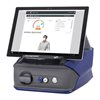Respirator Fit Testers
Respirators and masks play a crucial role in protecting workers from various airborne hazards, including environmental and chemical dangers, as well as airborne biohazards, in the workplace. Ensuring a proper respirator and mask fit test is equally vital for employee safety against respiratory hazards.
TSI® provides the leading respiratory protection testing solutions to help you make informed, data-driven decisions. Improve the efficiency and effectiveness of your respiratory protection program with TSI solutions that help support your workers' respiratory safety and to comply with regulated standards.
View Product Offering Buy PortaCount Accessories
| What is Respirator Fit Testing?
Fit testing evaluates the seal between a respirator and the face, identifying gaps or leaks that put workers at risk. Fit test results confirm if a mask will provide the right level of on-the-job protection needed. When implemented correctly, a respirator fit test and mask can help ensure that respiratory protection levels are achieved through a properly sized and donned respirator. |
Quantitative Respirator Fit Testing. The Highest Level of Protection.
Quantiative fit testing (QNFT) is the most accurate fit testing method - using data to calculate the fit factor. Passing a real-time quantitative respirator fit test proves that the face piece is sized and donned correctly, as well as provides for valuable opportunity for training.
PortaCount™ Respirator Fit Testing equipment measure the fit of the respirator or mask while the user simultaneously performs a series of moving, breathing, and talking exercises designed to simulate the same movements made in the field. With step-by-step guidance, the instrument walks you through the fit test. Once the fit test is complete, it is easy to generate reports. Choose the industry’s most accurate, fastest, and easy-to-use fit tester to increase your staff’s safety, with software and features to improve your program’s efficiency and productivity from training through regulatory compliance reporting.
 LEARN MORE about PortaCount™ Respirator Fit Tester
LEARN MORE about PortaCount™ Respirator Fit Tester
The Best Fit Test is now the FastestPortaCount™ Respirator Fit Tester complies with OSHA Modified CNC Protocols. |
Respirator Fit Test Comparison: Quantitative versus Qualitative MethodsBoth quantitative and qualitative fit testing methods are compliant. However, quantitative fit testing eliminates uncertainty for respiratory protection program administrators and users by objectively measuring the fit and providing objective data to make informed decisions to help keep staff safe. The main difference between quantitative respirator and mask fit testing and qualitative mask fit testing is that quantitative testing objectively measures the amount of leakage. In contrast, qualitative testing relies on the user's taste and smell to detect leakage. |
|
Resource: Quantatitive vs. Qualitative Testing 
Qualitative Fit Testing For Respirators. Enhance Your Fit Testing Process.
|
Qualitative fit testing (QLFT) is a inherently subjective (pass/fail) fit test method that has a higher level of variability across users. Qualitative Respirator Fit Testing (QLFT) with FitPro™ Ultra Fit Test Software helps remove the guesswork from the fit testing process with step-by-step visual guidance on conducting a qualitative respirator and mask fit test. If you’re not doing quantitative fit testing with PortaCount® Respirator Fit Tester, let’s help ensure you’re doing qualitative fit testing consistently and correctly. |
LEARN MORE about Qualitative Fit Testing Software (only available in the US)
 English
English
 汉语
汉语
 English
English
 Français
Français
 Deutsch
Deutsch


